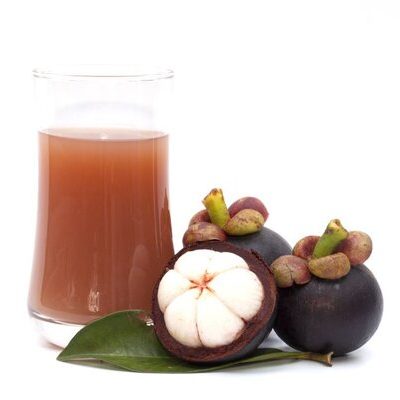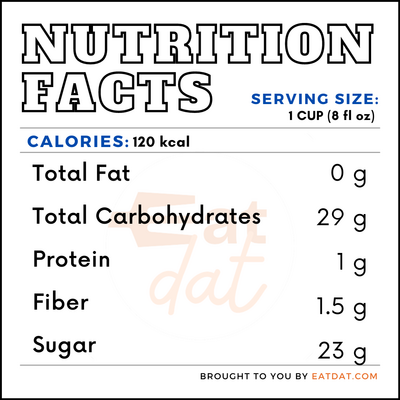
Mangosteen Juice
What is Mangosteen juice?
Mangosteen juice is made from the mangosteen fruit (Garcinia mangostana). Mangosteen is a tropical tree with an edible fruit that is native to Southeast Asia. The mangosteen fruit is sweet and juicy with a purple rind and white inner vesicles filled with liquid.
- Mangosteen juice is consumed as a stand-alone drink, although other uses for this exotic fruit include, puree for jams and desserts, as well as herbal tea.
- This fruit and its juice have gained a reputation for their many health benefits.
The top five most popular juice brands are:
- Mango.xan
- Thai-Go
- XanGo
- Naturally Thai Mangosteen
- Dynamic Health Mangosteen
Origin of mangosteen juice
Due to its widespread prehistoric cultivation, the exact origin of the this fruit is not known. However, it is believed that mangosteen originated from the Sunda Islands and the Moluccas. Cultivation started in Thailand or Burma, followed by Vietnam. Mangosteen was planted in Ceylon around 1800. In 1850, England introduced mangosteen to Trinidad. Later on, cultivation began in India around 1881. Following these events, the cultivation of this fruit and production of mangosteen juice has slowly made its way into different countries worldwide.
Nutrition
An 8 fluid ounce serving of mangosteen juice contains:

This fruit juice offers various health benefits. It is loaded with xanthones, an antioxidant found to be effective in helping reduce the signs of aging and fine lines. Also, this antioxidant protects the skin and body against free radicals. Furthermore, this juice has shown promise in treating urinary infections and menstrual disorders. Additionally, this juice may help stop the growth of fungi and bacteria.
Nonetheless, mangosteen has some possible side effects, like constipation, upset stomach, and, in extreme cases, bleeding disorders. This juice may slow down blood clotting, and as such overconsumption of it may reduce the body’s ability to stop bleeding. Also, this may increase the risk of bleeding during surgery. Furthermore, consumption during pregnancy is discouraged, as there is no reliable information on the safety of this juice for pregnant women.
Commercial production
This fruit is mostly found in Southeast Asia, Southwest India, and other tropical areas of South America, such as Colombia, Puerto Rico, and Florida, North America, where the tree was artificially introduced. The tree grows from 20 to 80 feet high. The white flesh inside fresh mangosteen fruit is used for the commercial production of this juice.
This portion is blended until a smooth paste is formed. Separately, water and sugar are stirred thoroughly by a mixing machine. After the sugar dissolves, the mangosteen paste and lemon are added in, and mixed thoroughly again. Preservatives may be added for long-term conservation, or the drink may be sold as natural fruit juice under strict refrigeration and storage.
Application
To release the mangosteen fruit from its rind, cut a circle into the skin around the stalk and calyx, and lift it off like a lid. This will reveal the segments of pearly flesh within, which can then be removed. Mangosteen has a delicious floral taste and is usually served very simply or blended for its juice.
Add mangosteen to a citrus jelly or granita, or serve the fruit segments in a fresh fruit salad. Lemongrass syrup, chamomile, and lemon juice all work well with mangosteen. Thai cooks often using this fruit juice in savory dishes to add a sweet note. The fresh juice can be safely stored in the fridge for a few days.
Mangosteen juice recipes
This fruit juice can add flavor to drinks and foods. Here are some popular recipes:
- Mangosteen Smoothie
- Mangosteen Passion Fruit Smoothie
- Mangosteen Popsicles
- Pineapple Mangosteen Juice
- Mango & Mangosteen Granita
FDA regulation
The FDA generally regulates all fruit juice producers on sanitary requirements and openness to inspection. The agency also ensures that fruit producers adhere to the regulatory power of other agencies responsible for the safety of fruit juices. Furthermore, the FDA has strict guidelines for the labeling of liquid dietary supplements, such as mangosteen juice.
References
Mangosteen, www.hort.purdue.edu/newcrop/morton/mangosteen.html.
Harvard Health. “Ask the Doctor: Does Mangosteen Have Any Health Benefits?” Harvard Health, www.health.harvard.edu/healthy-eating/does-mangosteen-have-any-health-benefits.
Hill, Ansley. “11 Health Benefits of Mangosteen (And How to Eat It).” Healthline, Healthline Media, 6 Mar. 2019, www.healthline.com/nutrition/mangosteen#TOC_TITLE_HDR_3.
“MANGOSTEEN: Overview, Uses, Side Effects, Precautions, Interactions, Dosing, and Reviews.” WebMD, WebMD, www.webmd.com/vitamins/ai/ingredientmono-1081/mangosteen.
Center for Food Safety and Applied Nutrition. “Juice HACCP Hazards and Controls Guidance First Edition.” U.S. Food and Drug Administration, FDA, www.fda.gov/regulatory-information/search-fda-guidance-documents/guidance-industry-juice-hazard-analysis-critical-control-point-hazards-and-controls-guidance-first
